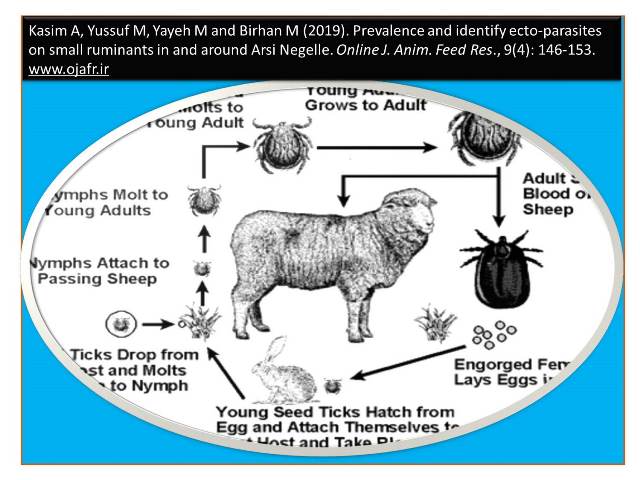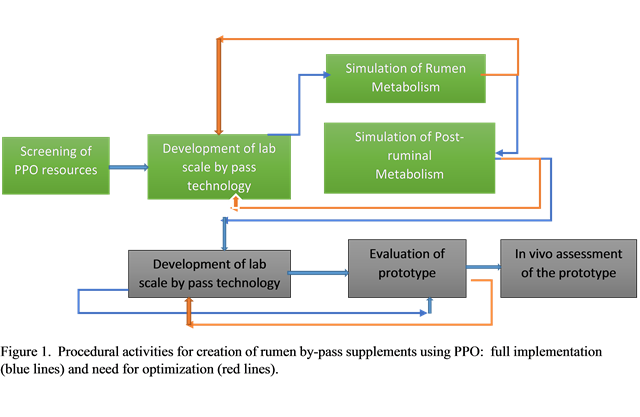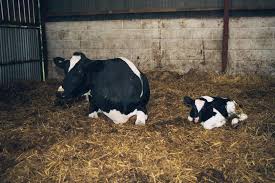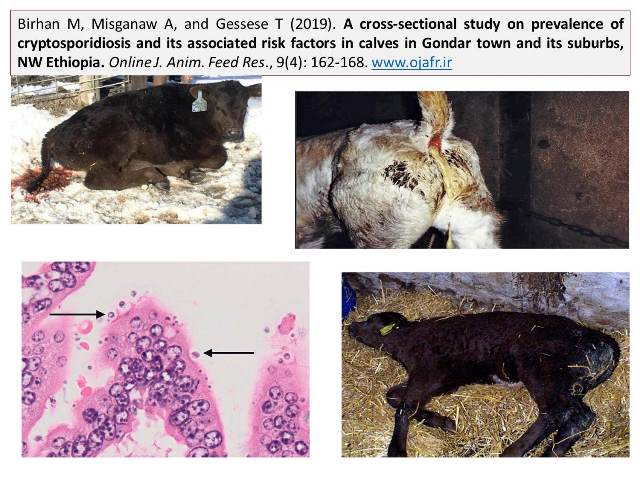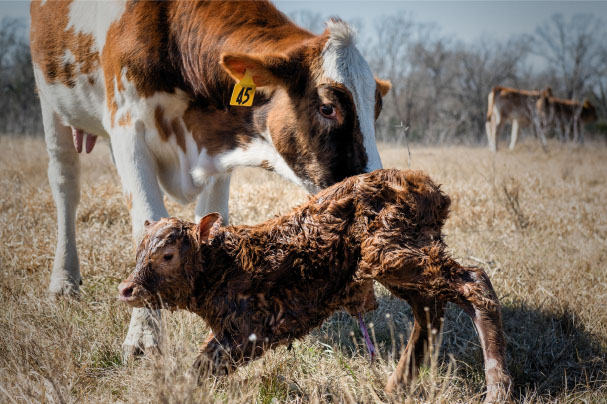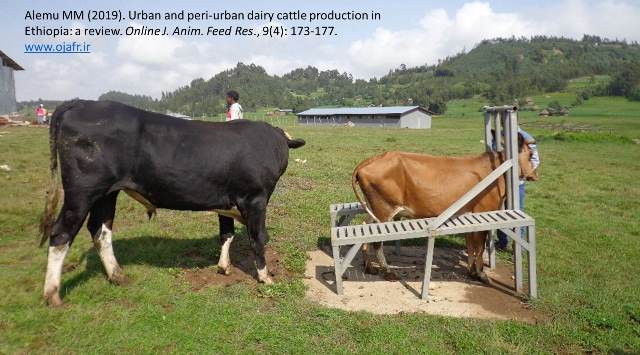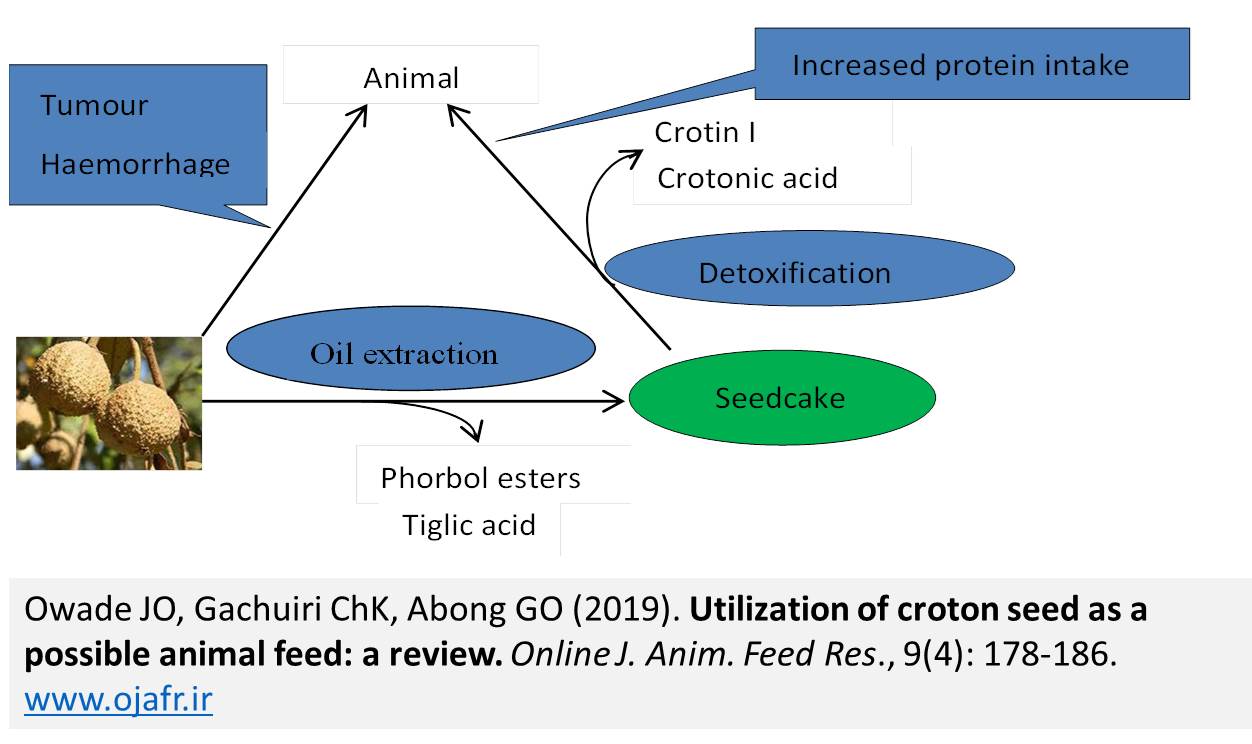Previous issue | Next issue | Archive
Volume 9 (4); July 25, 2019 [Booklet]
Prevalence and identify ecto-parasites on small ruminants in and around Arsi Negelle.
Kasim A, Yussuf M, Yayeh M and Birhan M.
Online J. Anim. Feed Res., 9(4): 146-153, 2019; pii: S222877011900019-9
Abstract
A cross sectional study was conducted to determine the prevalence and identify Ecto-parasites on small ruminants. A total of 422 small ruminants; sheep (n=246) and goats (n=176) were included in and around Arsi Negelle. Simple random sampling method was used to determine clinical infestated animal from healthy animals and data was analysed using SPSS 16 software for the description of p-value and chi-square. The result indicated that overall prevalence of ectoparasite in small ruminant was 126 (29.9%). Of which the prevalence of ectoparasite in sheep and goat was about 77 (31%) and 49 (27%), respectively. The most common ectoparasite encountered in order of their predominance were, lice (31.7%), flea (24.6), tick (19%), mixed (12.7%) and mite (12%). The statistical analysis indicated that sex (X2=13.774, P=0.0001), body condition (X2=40.463, P=0.0001) and age (X2=6.129, P=0.013) were some of the important factors showed significant difference to ectoparasite infestation of small ruminants. No statistical significant difference (P>0.05) were found between the species of small ruminants and ectoparasite infestations. The major ectoparasites at genus level identified on sheep and goat, were Ctenocephalides spp (23%), Bovicola (20.6%), Linognathus species (11.9%) Rhipicephaluses (8.7%), Amblyomma (7.1%), sarcoptes (7.1%), Hyalomma (5%) and Demodex (4.8). This study was conducted to identify the major ectoparasite and their prevalence on the small ruminants in study area. The most important ectoparasite identified, were lice, flea, ticks and mite. Therefore based on the findings following recommendations are forwarded: Strategic treatment of small ruminants with insecticides should be practiced in the study area to minimize the impact of ectoparasite on the health of animals; Awareness creation for the local farmers about the control of ectoparasite is essential and Further detailed study on economic loss associated with ectoparasite should be conducted.
Keywords: Ectoparasite, Prevalence, Small Ruminant, Arsi Negelle
[Full text-PDF]
Polyphenol oxidase containing extract: sources and contributions in animal nutrition.
Chanie D, Fievez V and Tegegne F.
Online J. Anim. Feed Res., 9(4): 154-157, 2019; pii: S222877011900020-9
Abstract
Polyphenol oxidase (PPOs) which are found naturally from plants, fruits, and vegetables and agricultural by products are getting considerable attention in food processing industries and in animal nutrition due to their antioxidant activity. Even though synthetic antioxidants have been used widely; they become a major cause for nutritional losses and quality deterioration which subsequently results in health problem in humans. To substitute synthetic antioxidants with natural Polyphenol oxidase (PPOs) containing extracts, many researches are being conducted on characterization of PPO sources and on protection of polyunsaturated oils and protein against ruminal degradation using PPO. Among many sources of PPO, Apple (malus sylevestris var domestica), Banana (Musa cavendishii) Mango (mangifera indicacv.manila) and Red clover (Trifolium pretense L.), Tomato stems (Solanum lycopersicum L.), Potato (Solanum tuberosum L.) are mentioned by different researchers from fruit sources and other plant sources, respectively. The contribution of PPO for protein and lipid protection is also being investigated. The main aim of this paper is to document the existing information on different sources and contribution of PPO as a baseline for further investigation. Further laboratory investigation on the role of polyphenol oxidase is crucial to improve the productivity of livestock with minimum feed cost.
Keywords: Polyphenol oxidase, Rumen, Protein degradation, Lipid degradation
[Full text-PDF]
Study on dystocia with history of uterine infections and calving hygiene along with subclinical endometritis in dairy cows in and around Gondar, NW Ethiopia.
Moges N.
Online J. Anim. Feed Res., 9(4): 158-161, 2019; pii: S222877011900021-9
Abstract
The aim of this study was to assess dystocia with history of uterine infections and calving hygiene on the characteristics of the intrauterine environment in dairy cows by cytological tests were performed on intrauterine perfusion fluid along with subclinical endometritis conducted between January 2016 to September 2017. The percentage of polymorphonuclear cells (neutrophil) was calculated. It was found that increase in the number of neutrophils correlated with increase subclinical endometritis. During the study period n=147 apparently healthy 3rd trimester pregnant cows were selected in dairy farms in and around Gondar, North Western Ethiopia. Questionnaire survey and regular follow up were conducted to determine subclinical endometritis in dairy cows. Abnormal parturition, uterine infections and calving hygiene were statistically significant (P<0.05) for subclinical endometritis. In conclusion, subclinical endometritis in postpartum dairy cows resulting in substantial economic losses due to decreases in both milk production and fertility.
Keywords: Calving hygiene, Cow, Dystocia, Gondar, Subclinical endometritis, Uterine infection
[Full text-PDF]
A cross-sectional study on prevalence of cryptosporidiosis and its associated risk factors in calves in Gondar town and its suburbs, NW Ethiopia.
Birhan M, Misganaw A, and Gessese T.
Online J. Anim. Feed Res., 9(4): 162-168, 2019; pii: S222877011800022-9
Abstract
Cryptosporidiosis is a common gastrointestinal disorder in humans and animals caused by various Cryptosporidium species. The present study was carried out to determine the prevalence of cryptosporidium oocyst and its potential risk factors in calves less than one year of age in and around Gondar town. For this purpose, 384 fecal samples (n=384 calves) from different dairy farms were collected and screened by using modified Ziehl-Neelsen staining technique. The overall prevalence of Cryptosporidium oocysts was 21.4 % (82/384). The association between different risk factors and prevalence of Cryptosporidium oocysts was assessed. There were significant associations (P<0.05) between prevalence of Cryptosporidium oocysts and age of calves, fecal consistencies, daily cleaning of the farm and water source. On the other hand, there was no significant association between prevalence of Cryptosporidium oocysts and sex, breed, and body condition of the calves and also provision of colostrums to the calves (P>0.05). In conclusion, this study demonstrated host factors and management factors greatly affect the prevalence of Cryptosporididosis in calves. Therefore, the current study reported the role of host factors (age and sex) and management factors (water source and daily cleaning of the farm) needed to be clearly recognized by all stakeholders in order to understand their effects on the disease occurrences as well as in control and prevention of in calves.
Keywords: Calves; Cryptosporidiosis; Dairy farm; Oocyst; Ziehl-Neelsen
[Full text-PDF]
Cytological Study of subclinical endometritis with respect to age, parity, farm scale and body condition score in dairy cows.
Moges N.
Online J. Anim. Feed Res., 9(4): 169-172, 2019; pii: S222877011800023-9
Abstract
The objective of this study was to investigate the incidence of subclinical endometritis with respect of age, parity, farm scale and body condition score in dairy cows. A total n= 147 of apparently healthy 3rd trimester pregnant cows were selected with no signs of clinical endometritis were examined from January 2016 to September 2017. Questionnaire survey and regular follow up were conducted to determine subclinical endometritis in dairy cows. Age and parity were statistically significant (P<0.05) for subclinical endometritis. Older cows greater than 6 years were more affected sub clinical endometritis 38 (71.70%) than younger cows 13 (29.55%) (χ2=51.97; P<0.05), the difference was statistically significant. The incidence of sub clinical endometritis in cows primiparous was 21 (40.38%) and multiparous was 46 (48.42%) (χ2=14.48; P<0.05), the difference is statistically significant. However, body condition score and farm scale showed no significant variation with regard to subclinical endometritis.
Keywords: Age, Body condition score, Cytology, Gondar, Parity, Subclinical endometritis
[Full text-PDF]
Urban and peri-urban dairy cattle production in Ethiopia: a review.
Alemu MM.
Online J. Anim. Feed Res., 9(4): 173-177, 2019; pii: S222877011800024-9
Abstract
Dairy production is among the developing agricultural sector in the urban and peri-urban areas of Ethiopia. This paper reviews the status of the current urban and peri-urban dairy cattle production systems and indicates possible recommendations. Hence management practices which includes feeds and feeding, breeding, housing and cattle holding are assessed based on different findings. Besides milk production potential, change drivers of the sector and major challenges are reviewed. The major feeds available for cattle are hay, crop residue and agro-industrial byproducts with stall feeding being the dominant system. In all reviewed findings both natural mating and AI is used though the preference is mostly affected by accessibility. Cities with highest population and better market and input access hold higher number of cattle per house hold than with lower population and market access. The average daily milk yield is higher in and around Addis Ababa followed by other big regional cities. High rate of urbanization, population growth, change in life style together with better access to inputs are behind the expansion of the sector. But shortage and cost of feed, shortage of land and waste disposal are the major challenges. Therefore, there is a need to organize the current status of the sector and look for solutions to cope up with the growing need of milk and milk products around the cities.
Keywords: Cattle Feeding, Dairy Breeding, Milk Production, Peri-Urban Dairy, Urban Dairy
[Full text-PDF]
Utilization of croton seed as a possible animal feed: a review.
Owade JO, Gachuiri ChK, Abong GO.
Online J. Anim. Feed Res., 9(4): 178-186, 2019; pii: S222877011800025-9
Abstract
Croton is one of the largest genera in the Family Euphorbiaceae. Its species are distributed in a wide range of environmental and climatic conditions. The plants have for a long time been exploited for medicinal purposes but still hold the potential for nutritional purposes. The seeds of the plant have been exploited in oil extraction to produce biofuel but the residual seedcake has been less utilized. The use of croton seed and seedcake as feed has been in practice in Kenya and other countries but questions on its safety have been raised. Croton seeds are known to contain various phytochemicals and toxins such as crotin I, crotonic acid and tiglic acid that have deleterious health effects on animals. Notwithstanding the rich nutritional composition of the croton seeds, its safety concerns have limited their utilization as feeds. The croton seeds are rich in both essential fatty acids and protein whereas the residual seedcake is only rich in protein. However, the seedcake has toxic phytochemicals that include cardiac glycocides, alkaloids, phorbal esters and many others which are injurious to the animals and could result in death. Detoxification of the seedcakes poses a breakthrough for their use in poultry feeding. However, such techniques should not reduce the rich nutritional property of these seeds. This review focuses on the utilization of croton seedcake as a possible animal feed, documenting breakthroughs and limitations of the practice.
Keywords: Croton, Seed, Seedcake, Nutrient composition, Safety, Detoxification
[Full text-PDF]
Previous issue | Next issue | Archive![]()
| < Prev | Next > |
|---|

